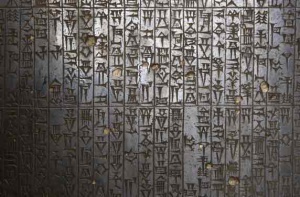Hammurabi Code

When the Code of Hammurabi appeared, the “king is already the source of justice; the judges are strictly supervised, and appeal to the king is allowed”.[1]
Over four thousand years ago in the kingdom of Ur, there were systematic methods and specified rules in courts of record. They settled, “disputes arising out of sales, inheritance, gifts, or divorce”. There were different kinds of courts with different jurisdictional authority. “When the claim had been ‘in the king’s name’ and rebutted, the case was settled by an oath either taken by one of the parties or by a witness.” [2]
You could be executed for questioning the authority of the princes and gods appointed by the king.
- “And Haran died before his father Terah in the land of his nativity, in Ur of the Chaldees.” Genesis 11:28
Haran did not just die, he was executed as a result of some presumed infraction of the codified laws. The word “died” is from (מ֖וֹת) muwth, which means “to die, kill, have one executed… to die prematurely… to kill, put to death, dispatch”. In the text we see "wayyāmāṯ kaśdîm bəūr mōwlaḏtōw" (אביו בארץ מולדתו באור כשדים׃)which is "died of the Chaldeese in Ur where (Haran) was a nativite."
Did Haran violate one of the Hammurabi Codes and was put to death?
Did Moses codify laws like Hammurabi and give men the power to put to death those who did not conform to his laws?
Draco of 7th century BC, also called Drako or Drakon meaning dragon or serpent. He was the first recorded legislator of Athens in Ancient Greece.
He replaced the prevailing system of oral law with a written code to be enforced only by a court of law created from the top down where the rulers were the fountainhead of justice and the people no longer have the power to decide fact and law. Draco was the first democratic legislator requested by the Athenian.
Draco codified laws characterized by extreme harshness which led to the establishment of the adjective draconian meaning the unforgiving rules or laws.
We see the codification of laws under Hammurabi Codes with the same merciless death penalties.
Solon, would repeal most of those laws twenty five years later, including those related to debt slavery.
The death penalty remained the law on murder.
Power to rule
The power to rule and make law for the people comes from the power to create a table of dainties which the people desire to consume.
An early codified universal government welfare was instituted in the 7th century (634 CE) in the time of the Rashidun caliph Umar. The first modern welfare state was Imperial Germany (1871–1918), where the Bismarck government introduced social security in 1889. These all led to tyrany.
But Sumer existed as a welfare city -state long before and likely Cain and Nimrod were also welfare states with codes and laws enforced by government instead of the people. Sodom also weakened the people in a time of affluence. Certainly Rome had their system of free bread that subjected the people.
Proverbs and Polybius to say nothing of Plutarch all warned that the dainties of rulers were deceitful meats. Peter, Paul, and David warned that their welfare tables were a snare and the covetous practices they allow makes people merchandise.